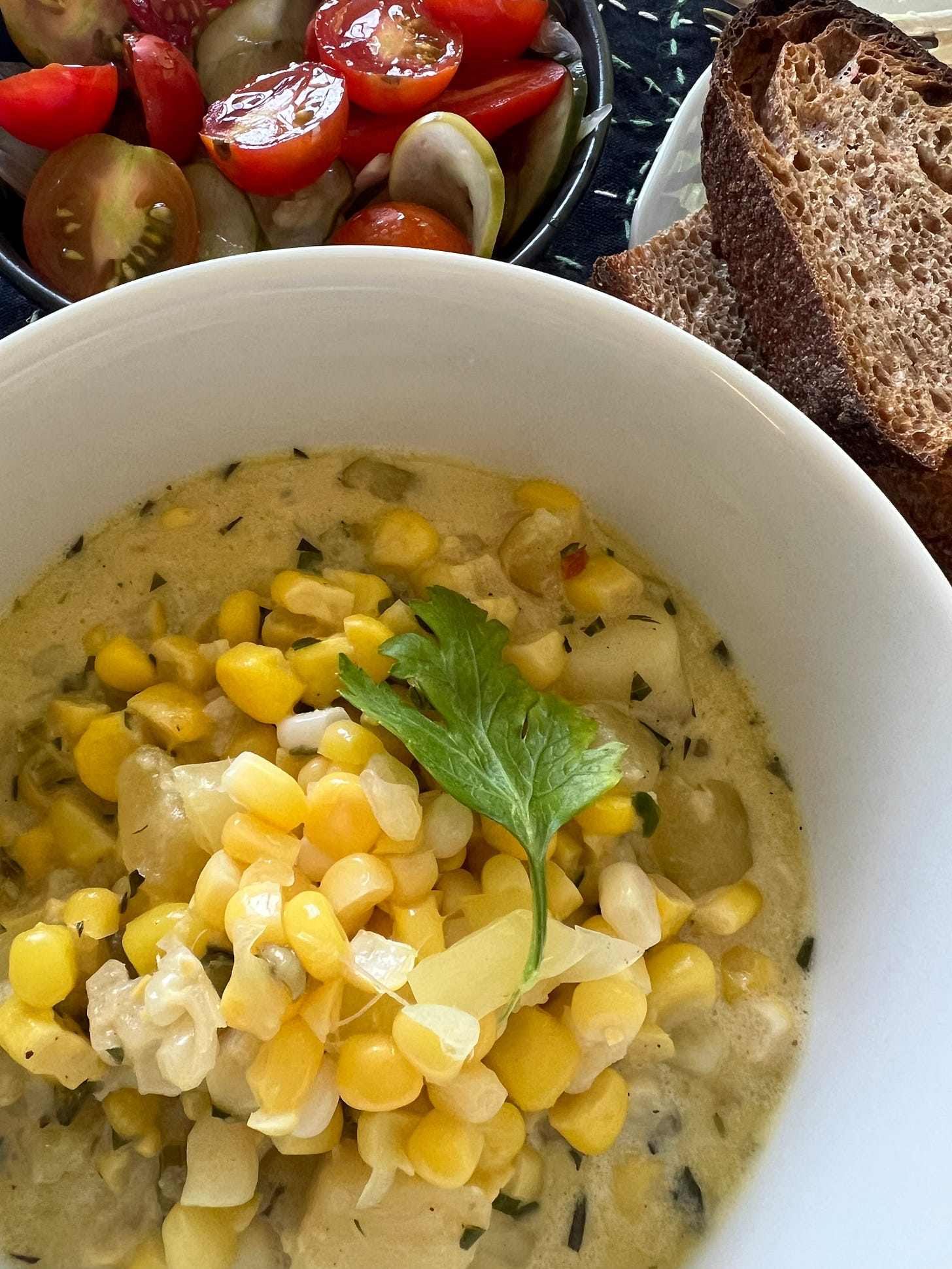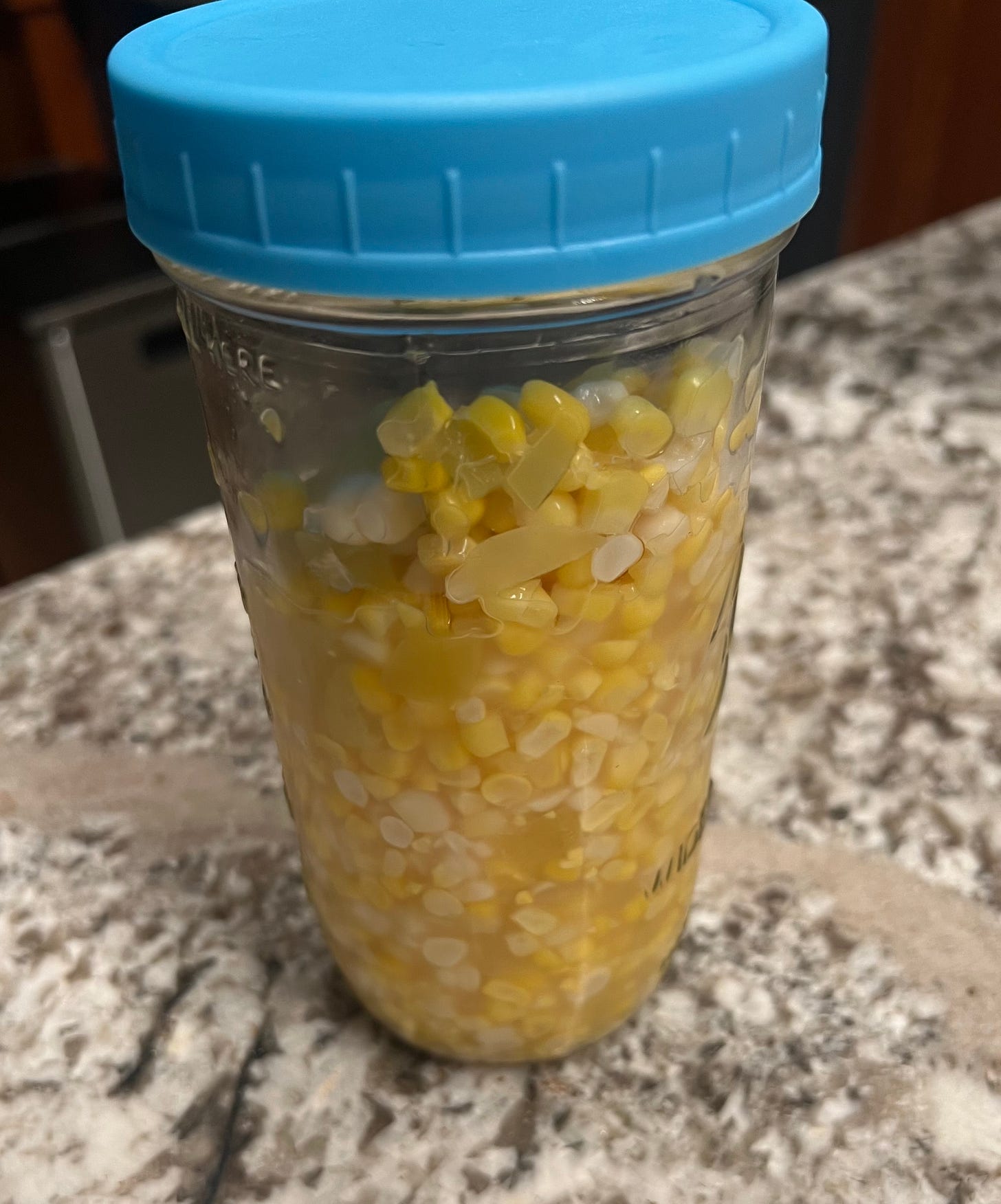Issue #172: Corn Chowdah
A Timely Recipe from a Friend, Evidence of Harmonic Convergence, A Fermented Corn Relish
I’m not sure what the Substack propriety is about reposting a recipe you just received in someone else’s newsletter. But when Nancy Harmon Jenkins’s On the Kitchen Porch arrived in my inbox last week, I was so excited to have everything I needed to make her recipe for corn chowder, I set to it right away. And it was so simple, delicious, and perfect for this post–Labor Day moment, when corn is still aplenty in the market, but you could swear the days are already getting a little shorter and the nights a little chillier, that I wanted to share it with my readers this week. Help absolve me of any impropriety by subscribing to Nancy’s Substack here.
I’m married to someone who doesn’t like soup. I knew it at the time and went ahead with the ceremony, anyway. For Nate, soup falls into the category of “hot liquids,” such as coffee and tea, which he also doesn’t like. He’s an iced coffee and tea drinker, even in the dead of winter. Chunky soups have the added disadvantage of a heterogenous texture, which is something that doubly turns him off, I’ve deduced, by the simple fact that if you purée a chunky soup and add cream, he’ll eat it.
That said, there are a few soups for which Nate makes blanket exceptions. He loves my matzo ball soup, for example. His taste for this hot liquid must have something to do with genetics and/or faith, which, in my family was rooted in gastronomy, not religion, and had more to do with brisket, latkes, and matzo balls than HaShem. Nate also always enjoys my pappa al pomodoro, the Tuscan tomato bread soup, which, by the time the salt-free Tuscan bread has soaked up all the liquid and dissolved into pulp, is really more like a porridge, anyway.
I’ve not tried to put many chowders in front of him, in part, because they are chunky and because most of them are built on seafood, of which he’s also not the biggest fan. In fact, when I made Nancy’s corn chowder the other day, it was intended for me for dinner on a night when Nate had a work event to attend. I hadn’t anticipated him eating any at all.
Good Home Cooking
Nancy’s Substack recipe was written in paragraph form, with many suggestions of things you could add or not—the sort of recipe I think is best suited to home cooks, who likely won’t have exactly this or exactly that and it doesn’t matter, anyway.
Instead of the bacon, pancetta, or guanciale that Nancy called for, I had a cube of ham fat in the freezer from a leg I cured and smoked last year. I just couldn’t throw out the thick layer of flavorful fat that surrounded the meat of my ham, so I cubed it and froze it for just this sort of occasion. Instead of heavy cream, I had some crème fraiche I had made by culturing heavy cream from a local dairy that was only available in a two-quart bottle. That’s a lot of cream. I cultured it so it would keep, which it has, proving again that our forebears knew a thing or two about what was good and practical in the kitchen.
The chowder came out great. I had two bowls for dinner that night. And I put the rest in the fridge for future lunches. The next day, wouldn’t you know it, Nate worked from home. When presented with the options for lunch, to my surprise, he wanted to try the chowder. “This is really good,” he proclaimed. We had it again a few nights later for dinner.
When Stars Align
While I was making the chowder, I experienced a tingle of harmonic convergence when I realized as I reached for my olive oil that I was actually using oil from Nancy’s home in Tuscany, where I’ve had the good fortune of spending many a summer’s afternoon and an occasional overnight. Nancy’s daughter, Sara Jenkins, also a friend, has a lovely restaurant in Rockport, Maine, Nina June, which we visit a couple of times a year.
After a recent meal at Sara’s earlier this year, I noticed several cans of oil from the most recent harvest of olives at their home in Teverina, a tiny Tuscan village in the hills outside of Cortona. I purchased a few for gifts and a few for myself. Fast forward several months and here I was making Nancy’s recipe for corn chowder from her newsletter using her olive oil. What a small, interconnected culinary world. Perhaps that harmony is what Nate tasted in the bowl.
For you, dear reader, I’m going to paraphrase Nancy’s recipe, tweaking it to replicate what I did and reformulating it in the style I use for recipes in this newsletter. To experience the charm of Nancy’s writing and to learn when and how she adds beans and/or cherry tomatoes to her corn chowder, you’ll just have to subscribe to her newsletter yourself.
RECIPE: Nancy’s New England Corn Chowder
Makes 6 servings
1 tablespoon butter
3 tablespoons olive oil, divided
2 ounces bacon, pancetta, guanciale, or ham fat, cut into tiny cubes
1 medium onion, chopped
Salt
1 pound potatoes, peeled and diced
3 or 4 ears fresh corn
Pinch red chili powder or flakes
Juice of 1 lime
1 1/2 cups light chicken stock, vegetable stock, or dashi (which is what I used because I just got back from Japan with a lot of dashi tea bags)
1 cup whole milk
1/2 cup heavy cream or crème fraiche
2 bay leaves
Freshly ground black pepper
Handful fresh herbs, such as basil, parsley, tarragon, and/or dill
Combine the butter and a tablespoon of the olive oil in a large saucepan and set over medium-high heat. Add the bacon and fry until the fat renders and the remaining bits brown and crisp. With a slotted spoon, remove the crisped bits and set aside. Add the onion to the pan with a pinch of salt and cook until soft, 4 or 5 minutes. Add the potatoes and cook, stirring, so they begin to absorb the flavor of the fat.
While the potatoes and onions are cooking, heat a large frying pan with the remaining 2 tablespoons of olive oil. Using your preferred method, cut the kernels from the cobs—I slice them off the cob over the pan, which I probably shouldn’t advise, but it works for me—and add to the pan. Using a spoon, scrape the cobs to extract any milky liquid—something I’ve never done before Nancy told me to do it—and add this to the pan, as well. Cook the corn kernels, stirring often, until they begin to caramelize and brown slightly, 7 or 8 minutes. A starchy film will form and brown on the bottom of the pan. Keep stirring. Once browned, add a generous pinch of salt and a less generous pinch of chili. Add the juice of a lime, and then transfer everything into the saucepan with the potatoes and onions.
Put the corn pan back on the stove over a medium-high flame and add about half the stock. While it boils, deglaze the pan by scraping the bottom with a wooden spoon so you get all that flavorful corn goodness that was stuck to it. Pour this into the pot as well, along with the remaining stock. Let simmer a few minutes until the potatoes are soft. Add the milk and cream, the bay leaves, and a generous amount of black pepper, and continue cooking for 15 minutes or so until everything comes together. Stir in the chopped herbs. Taste, adjust the seasoning and serve.
Not Done with Corn Yet
Before I headed out for my trip to Venice over Labor Day Weekend, I had a couple of ears of corn from our CSA that I wasn’t able to consume. I decided to turn them into a lacto-fermented corn relish, which would have just the right amount of time to ripen while I was gone.
Although I’m no stranger to fermenting, I am constantly surprised by things I learn people ferment that I never considered. A few years ago I was at a Chef’s Manifesto gathering at the beautiful OmVed Gardens in London. One of the resident chef/gardeners served us a variety of lacto-fermented beans to try. Who knew you could ferment beans?
I had the same feeling when I recently stumbled on a post on Instagram about lacto-fermented corn. (I’m sorry, but I can’t recall who it was.) Why had I never thought of that? So, I combined my corn with some bell peppers I also needed to use up and made a tangy delicious relish that I used to garnish this delicious corn chowder.
RECIPE: Lacto-Fermented Corn Relish
Makes a little more than a pint
Kosher salt
2 or 3 ears fresh corn, kernels removed from the cob
1 or 2 small bell peppers, chopped
1/2 small white onion, chopped
Handful of chopped herbs (optional)
You need a salt solution of 2.5% to 3% salinity for optimal lacto-fermentation. To obtain this, combine 500 ml water with 12.5 to 15 grams of salt and heat it in the microwave, stirring occasionally, until the salt totally dissolves. Let cool to room temperature.
In a medium mixing bowl, combine the corn kernels, peppers, onion, and herbs, if using. Pack them into a clean mason jar. (I used an unusual 3-cup Ball jar.) Fill with the salt solution a good ½ inch above the kernels. (If you need more, make it in the same proportion.) It’s best to weigh the corn down somehow so it stays submerged in the brine. I use little glass weights that came with self-burping fermentation mason jar lids, but you can use a plastic bag full of water or rocks. Cover the jar and let sit for 4 or 5 days, burping the jar each day to release gas. You should see the relish turn a little cloudy and effervescent as it sits. Remove the weight and taste to determine tanginess. Keep it going longer for more. Once it reaches the right taste for your preference, store in the refrigerator indefinitely.







Thanks for the shout-out, Mitchell, for my Substack, Sara's restaurant, and our olive oil. And just to show that what goes around comes around, I cited your contribution to The Jewish Holiday Table in the Substack I posted yesterday and directed readers to your platform. Clearly, we have a mutual admiration society going on here.